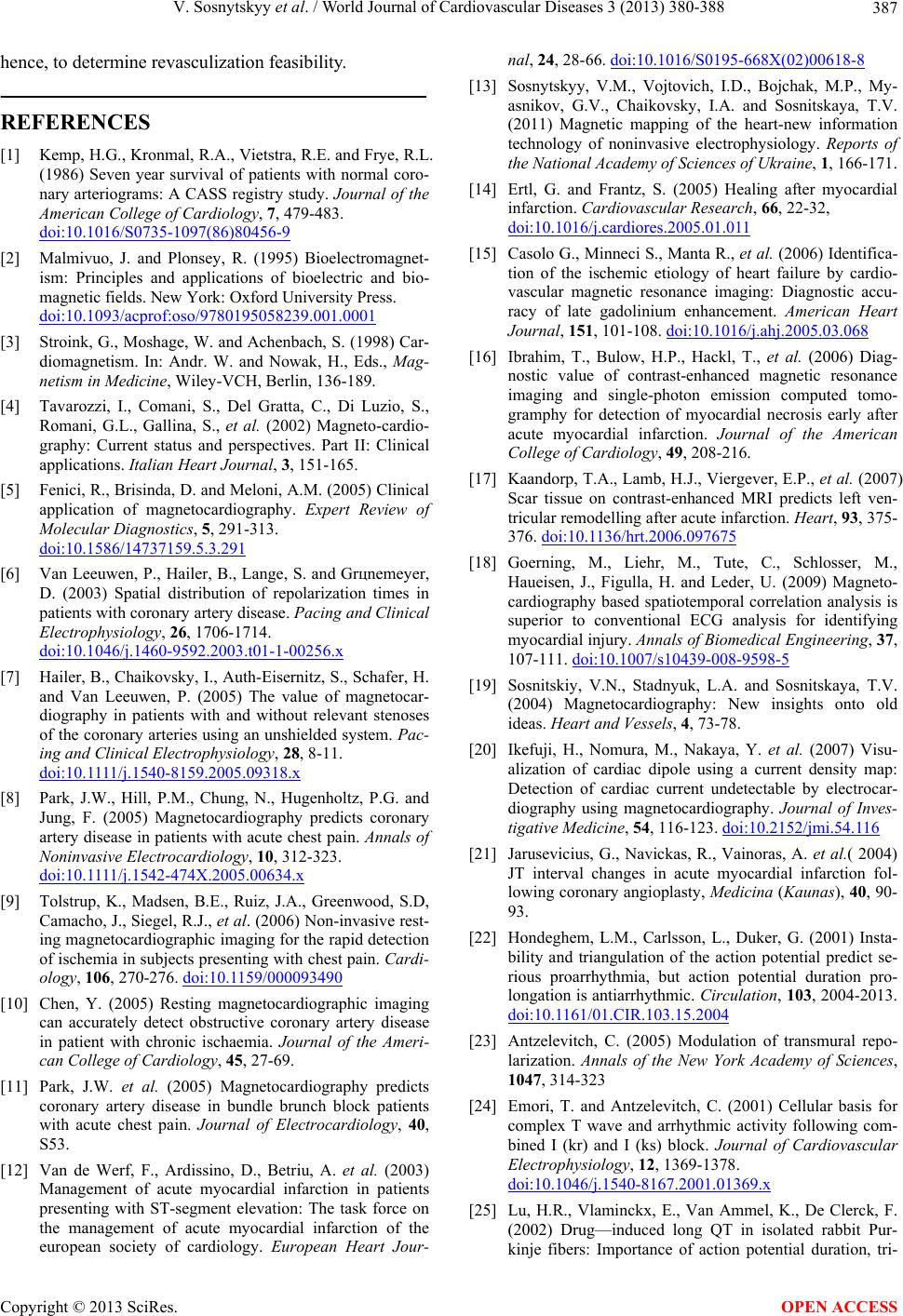
V. Sosnytskyy et al. / World Journal of Cardiovascular Diseases 3 (2013) 380-388 387
hence, to determine revasculization feasibility.
REFERENCES
[1] Kemp, H.G., Kronmal, R.A., Vietstra, R.E. and Frye, R.L.
(1986) Seven year survival of patients with normal coro-
nary arteriograms: A CASS registry study. Journal of the
American College of Cardiology, 7, 479-483.
doi:10.1016/S0735-1097(86)80456-9
[2] Malmivuo, J. and Plonsey, R. (1995) Bioelectromagnet-
ism: Principles and applications of bioelectric and bio-
magnetic fields. New York: Oxford University Press.
doi:10.1093/acprof:oso/9780195058239.001.0001
[3] Stroink, G., Moshage, W. and Achenbach, S. (1998) Car-
diomagnetism. In: Andr. W. and Nowak, H., Eds., Mag-
netism in Medicine, Wiley-VCH, Berlin, 136-189.
[4] Tavarozzi, I., Comani, S., Del Gratta, C., Di Luzio, S.,
Romani, G.L., Gallina, S., et al. (2002) Magneto-cardio-
graphy: Current status and perspectives. Part II: Clinical
applications. Italian Heart Journal, 3, 151-165.
[5] Fenici, R., Brisinda, D. and Meloni, A.M. (2005) Clinical
application of magnetocardiography. Expert Review of
Molecular Diagnostics, 5, 291-313.
doi:10.1586/14737159.5.3.291
[6] Van Leeuwen, P., Hailer, B., Lange, S. and Grцnemeyer,
D. (2003) Spatial distribution of repolarization times in
patients with coronary artery disease. Pacing and Clinical
Electrophysiology, 26, 1706-1714.
doi:10.1046/j.1460-9592.2003.t01-1-00256.x
[7] Hailer, B., Chaikovsky, I., Auth-Eisernitz, S., Schafer, H.
and Van Leeuwen, P. (2005) The value of magnetocar-
diography in patients with and without relevant stenoses
of the coronary arteries using an unshielded system. Pac-
ing and Clinical Electrophysiology, 28, 8-11.
d oi:10.1111/j.15 40-8159.2005.09318.x
[8] Park, J.W., Hill, P.M., Chung, N., Hugenholtz, P.G. and
Jung, F. (2005) Magnetocardiography predicts coronary
artery disease in patients with acute chest pain. Annals of
Noninvasive Electrocardiology, 10, 312-323.
d oi:10.1111/j.15 42-474X.2005.00634.x
[9] Tolstrup, K., Madsen, B.E., Ruiz, J.A., Greenwood, S.D,
Camacho, J., Siegel, R.J., et al. (2006) Non-invasive rest-
ing magnetocardiographic imaging for the rapid detection
of ischemia in subjects presenting with chest pain. Cardi-
ology, 106, 270-276. doi:10.1159/000093490
[10] Chen, Y. (2005) Resting magnetocardiographic imaging
can accurately detect obstructive coronary artery disease
in patient with chronic ischaemia. Journal of the Ameri-
can College of Cardiology, 45, 27-69.
[11] Park, J.W. et al. (2005) Magnetocardiography predicts
coronary artery disease in bundle brunch block patients
with acute chest pain. Journal of Electrocardiology, 40,
S53.
[12] Van de Werf, F., Ardissino, D., Betriu, A. et al. (2003)
Management of acute myocardial infarction in patients
presenting with ST-segment elevation: The task force on
the management of acute myocardial infarction of the
european society of cardiology. European Heart Jour-
nal, 24, 28-66. doi:10.1016/S0195-668X(02)00618-8
[13] Sosnytskyy, V.M., Vojtovich, I.D., Bojchak, M.P., My-
asnikov, G.V., Chaikovsky, I.A. and Sosnitskaya, T.V.
(2011) Magnetic mapping of the heart-new information
technology of noninvasive electrophysiology. Reports of
the National Academy of Sciences of Ukraine, 1, 166-171.
[14] Ertl, G. and Frantz, S. (2005) Healing after myocardial
infarction. Cardiovascular Research, 66, 22-32,
doi:10.1016/j.cardiores.2005.01.011
[15] Casolo G., Minneci S., Manta R., et al. (2006) Identifica-
tion of the ischemic etiology of heart failure by cardio-
vascular magnetic resonance imaging: Diagnostic accu-
racy of late gadolinium enhancement. American Heart
Journal, 151, 101-108. doi:10.1016/j.ahj.2005.03.068
[16] Ibrahim, T., Bulow, H.P., Hackl, T., et al. (2006) Diag-
nostic value of contrast-enhanced magnetic resonance
imaging and single-photon emission computed tomo-
gramphy for detection of myocardial necrosis early after
acute myocardial infarction. Journal of the American
College of Cardiology, 49, 208-216.
[17] Kaandorp, T.A., Lamb, H.J., Viergever, E.P., et al. (2007)
Scar tissue on contrast-enhanced MRI predicts left ven-
tricular remodelling after acute infarction. Heart, 93, 375-
376. doi:10.1136/hrt.2006.097675
[18] Goerning, M., Liehr, M., Tute, C., Schlosser, M.,
Haueisen, J., Figulla, H. and Leder, U. (2009) Magneto-
cardiography based spatiotemporal correlation analysis is
superior to conventional ECG analysis for identifying
myocardial injury. Annals of Biomedical Engineering, 37,
107-111. doi:10.1007/s10439-008-9598-5
[19] Sosnitskiy, V.N., Stadnyuk, L.A. and Sosnitskaya, T.V.
(2004) Magnetocardiography: New insights onto old
ideas. Heart and Vessels, 4, 73-78.
[20] Ikefuji, H., Nomura, M., Nakaya, Y. et al. (2007) Visu-
alization of cardiac dipole using a current density map:
Detection of cardiac current undetectable by electrocar-
diography using magnetocardiography. Journal of Inves-
tigative Medicine, 54, 116-123. doi:10.2152/jmi.54.116
[21] Jarusevicius, G., Navickas, R., Vainoras, A. et al.( 2004)
JT interval changes in acute myocardial infarction fol-
lowing coronary angioplasty, Medicina (Kaunas), 40, 90-
93.
[22] Hondeghem, L.M., Carlsson, L., Duker, G. (2001) Insta-
bility and triangulation of the action potential predict se-
rious proarrhythmia, but action potential duration pro-
longation is antiarrhythmic. Circulation, 103, 2004-2013.
doi:10.1161/01.CIR.103.15.2004
[23] Antzelevitch, С. (2005) Modulation of transmural repo-
larization. Annals of the New York Academy of Sciences,
1047, 314-323
[24] Emori, T. and Antzelevitch, C. (2001) Cellular basis for
complex T wave and arrhythmic activity following com-
bined I (kr) and I (ks) block. Journal of Cardiovascular
Electrophysiology, 12, 1369-1378.
doi:10.1046/j.1540-8167.2001.01369.x
[25] Lu, H.R., Vlaminckx, E., Van Ammel, K., De Clerck, F.
(2002) Drug—induced long QT in isolated rabbit Pur-
kinje fibers: Importance of action potential duration, tri-
Copyright © 2013 SciRes. OPEN ACCESS